The AMD Ryzen 7 5800X3D Review: 96 MB of L3 3D V-Cache Designed For Gamers
by Gavin Bonshor on June 30, 2022 8:00 AM EST- Posted in
- CPUs
- AMD
- DDR4
- AM4
- Ryzen
- V-Cache
- Ryzen 7 5800X3D
- Zen3
- 3D V-Cache
Final Words
For users in the market for a new CPU designed to bolster frame rates in a gaming system, the AMD Ryzen 5800X3D is undoubtedly a powerful choice.
Even at $449, the Ryzen 7 5800X3D can perform as well, if not at times better than any chip from Intel's 12th Gen Core series of processors. The catch is that, as is often the case with new/unique technologies, the gains are uneven among games. This essentially means if the game doesn't benefit from the large 96 MB of 3D V-Cache onboard, it performs similar to the already existing Ryzen 7 5800X, which can be had for $350; $100 cheaper than the 5800X3D. In that respect, it would be helpful if AMD published a guide of games that they've found to materially benefit from the large L3 cache, just so gamers and users could decide whether the Ryzen 7 5800X3D is worth it.
The other angle is that, compared to the Intel ecosystem, the Intel Core i7-12700K for $380 represents a better buy in terms of all-around performance, where it has the advantage in most CPU compute workloads. So while the Ryzen 7 5800X3D has a niche it does quite well at, there's certainly an opportunity cost in getting this chip versus something that is a bit more rounded.
Let's dissect the performance across the different areas such as gaming and compute:
AMD Ryzen 7 5800X3D Analysis: Biased Towards Gamers
Looking at our data across our CPU testing suites (compute and gaming), the AMD Ryzen 7 5800X3D is a mixed bag. The Ryzen 7 5800X3D has an MSRP of $449 and represents a $100 hike over what the original Ryzen 7 5800X ($350) is currently selling for. Now let's dissect our analysis into two sections, gaming and compute, and piece it together.
AMD Ryzen 7 5800X3D Gaming Analysis: 3D V-Cache is Fantastic For Some Games (But Not All)
When AMD initially announced its Ryzen 7 5800X3D processor with its latest technological advancement in 3D V-Cache stacking, AMD made it clear that this processor was explicitly designed for gamers. The idea was that the additional levels of L3 Cache would play more to gamer's strengths with a larger buffer for more frequently used data instead of directly accessing it from system memory (DRAM). In gaming, a larger pool of L3 cache can indeed benefit and improve frametimes, as this data is closer to the CPU cores and is more quickly accessed by the individual cores from the processor as it would when accessing it from DRAM.
Now it's worth mentioning that in our testing, AMD's V-Cache-equipped chip didn't annihilate the competition in all of the games in our suite. Still, it certainly significantly impacted AMD-favored titles in its arsenal.
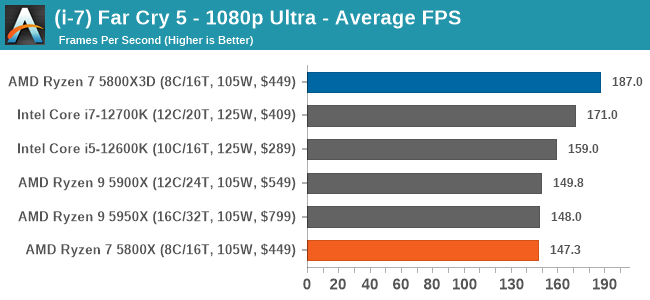
Looking at performance in Far Cry 5 at 1080p Ultra, which is notably an AMD partnered title, the AMD Ryzen 7 5800X3D with 96 MB of 3D stacked L3 Cache performed just under 27% faster than the previous AMD Ryzen 7 5800X processor. It was also around 9% better than the similarly priced Intel Core i7-12700K, which benefits from four more cores, higher IPC performance, and faster cores than the 5800X3D.
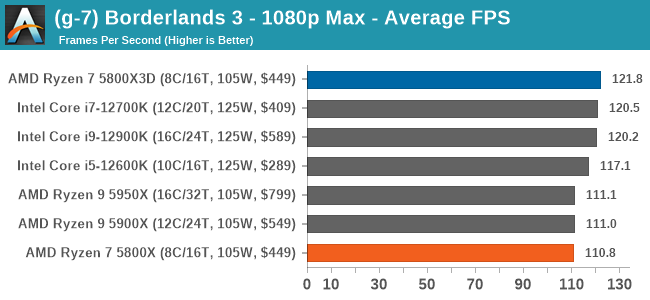
In Borderlands 3 at 1080p with maximum settings, the AMD Ryzen 7 5800X3D also topped our tables, even beating out the more expensive and premium Intel Core i9-12900K by over 1%, and beats all of the other Ryzen 5000 processors tested. This does give AMD some affirmation that its 3D V-Cache can push its technology as a win for gamers. Still, unfortunately, not every game title will benefit from massive levels of L3 Cache.
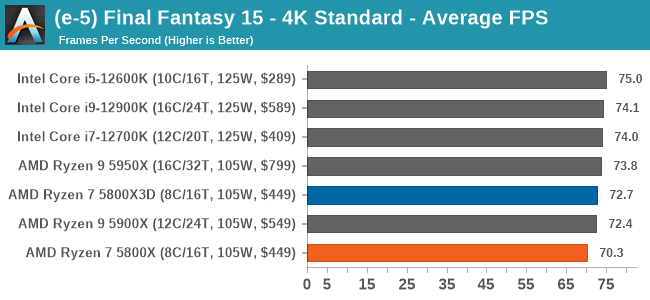
As for 4K gaming, there's not a lot to say here. This is almost always the realm of GPU-limited games, which limits the benefits a faster CPU can bring. Focusing on Final Fantasy 15 at 4K resolutions and using the standard preset, the 96 MB of L3 didn't have the desired effect on performance. The Ryzen 7 5700X3D does pull ahead, beating the previous Ryzen 7 5800X by around 3.4%, but it's small potatoes at this point.
AMD Ryzen 7 5800X3D Compute Analysis: Extra L3 Does Little For Compute Performance
While AMD pitched the Ryzen 7 5800X3D and its 96 MB of L3 cache as being beneficial in gaming, they didn't make the same kind of claims when it comes to applications and general compute performance. Because the benefits of a larger L3 cache are even more sporadic in these cases, AMD has wisely opted not to promote the part based on general compute performance here. Which is not to say that it's bad news for AMD, but as our data confirms, the L3 cache generally doesn't have much of an impact here.
It's worth noting that due to the 3D V-Cache, which is essentially 32 MB + 64 MB stacked vertically on top of each other using AMD's new chiplet packaging technology, AMD has had to be more conservative with core frequency to be in line with its 105 W TDP power rating. In comparison to the Ryzen 7 5800X, which has a base frequency of 3.8 GHz and a turbo core clock speed of 4.7 GHz, the Ryzen 7 5800X3D has a 400 MHz lower base frequency of 3.4 GHz, which its turbo core frequency is 200 MHz lower by comparison with a maximum core frequency of 4.5 GHz. This reduction in core frequency plays a key role in compute performance when directly comparing the 5800X3D and 5800X.
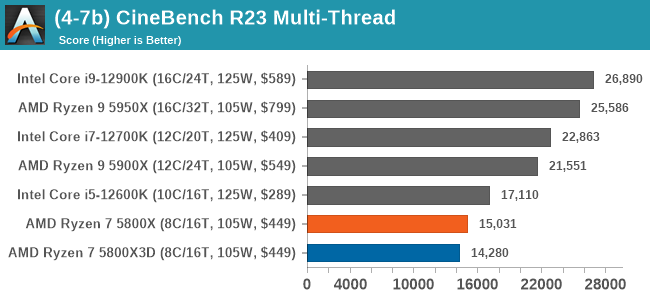
Looking at multi-threaded performance in Cinebench R23, the Ryzen 7 5800X3D performs 5.2% worse off than the existing Ryzen 7 5800X. This can be directly attributed to the differences in core frequency.
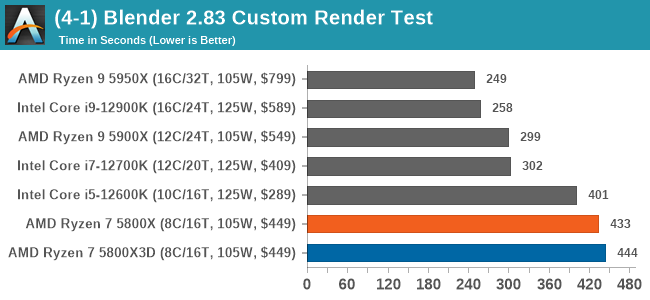
In our Blender 2.83 benchmark, the additional 64 MB of L3 cache on the Ryzen 7 5800X3D over the Ryzen 7 5800X made no difference in performance. Once again, the extra 3D stacked L3 V-Cache made no real impression on compute performance. With the critical sections of many non-gaming workloads either fitting within the confines of current L3 caches – or not fitting at all – there's no making up for more cores and higher clockspeeds most of the time.
AMD Ryzen 7 5800X3D is For Gaming, But Compute Performance is Average
Touted as the 'World's Fastest PC Gaming Processor' by AMD, this claim rings true in some aspects but not so much in others. The keyword in this claim is gaming, and it's true that the additional 64 MB of L3 cache does bring many benefits to the gaming market, albeit benefiting some games more than others.
The general outcome of our analysis is straightforward. If a specific title can benefit from a larger L3 cache, then the Ryzen 7 5800X3D and its 3D stacked V-Cache will prove very potent and fruitful to gamers looking to maximize frame rates. In situations where the game cannot benefit from the extra L3 cache, then the Intel 12th Gen Core series chips prove better with higher core clock speeds and higher IPC leading to higher overall performance.
The biggest benefits to gaming performance came in 720p and lower resolutions – which is to be expected since the CPU-limited scenario is something of a best case here – but the Ryzen 7 5800X3D at 1080p and 4K proved fruitful in selected titles. So even in workloads where the CPU isn't entirely free to run ahead of the GPU, it's clear that there's still some benefit to AMD's latest chip.
Otherwise, when it comes to raw compute performance, the Ryzen 7 5800X3D isn't as potent as Intel's 12th Gen Core processors – and in most of our computational-related tests, it also fell behind the vanilla Ryzen 7 5800X processor. This is because the L3 cache doesn't have as much of an influence on general purpose compute performance, and the Ryzen 7 5800X3D is clocked slightly lower due to voltage restraints (1.35 V) on the VCore.
Ultimately, It's pretty easy to make a case for the Ryzen 7 5800X3D as a solid gaming chip, especially as it decimates the competition in some titles. Just so long as potential buyers understand that the Ryzen 7 5800X3D is going to excel in gaming more than it excels in Excel. Otherwise, for users looking for a solid all-rounder capable of reasonable frame rates in gaming and reliable application and productivity performance, the Intel Core 12th Gen series has a little more oomph under the hood, albeit with a much higher power draw.
Performance matters aside, the Ryzen 7 5800X3D and its other V-cache ilk represent a massive step forward for AMD's engineering team. Stacking additional L3 cache is a novel way to expand the size of the L3 pool without significantly blowing up die sizes or resort to high-latency off-die caches, which gives AMD some important flexibility here to make such a part viable.
And clearly, AMD is happy with what they've accomplished as well. Along with the Ryzen chip, AMD has rolled out V-cache chips for enterprise and server products, where it is already playing a critical factor in performance. As a result, it comes as no surprise that AMD has confirmed that there will be 3D V-Cache products on its impending Zen 4 core (due fall 2022), and with Zen 5 which is expected sometime in 2024, with both consumer (Ryzen) and server (EPYC) products planned. So while all signs point to V-cache remaining a premium solution, it also means that we're far from done seeing what AMD can do for PC performance with larger L3 caches.


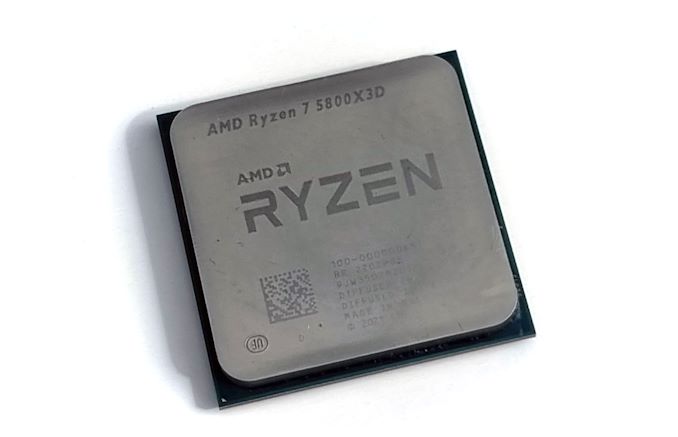








125 Comments
View All Comments
GeoffreyA - Friday, July 8, 2022 - link
"BTW, 24 fps movies look horrible to me. 24 fps is something they settled on way back when film was heavy, bulky, and expensive."I can't help commenting that, for my part, movies look unsightly over 24 fps, giving them a low-quality TV-like appearance. Then again, that's me, a person who can't stand digital cameras to begin with and laments the phasing out of film.
mode_13h - Friday, July 8, 2022 - link
> for my part, movies look unsightly over 24 fps, giving them a low-quality TV-like appearance.I know some people say that, but when you get accustomed to watching good quality motion interpolation, it's hard to go back.
Even famous Hollywood actors and directors have complained about motion interpolation, but I think the main thing they're worried about is that it reveals subtleties in their facial expressions that can reveal sub-par acting. For things like camera pans and action sequences, it's pretty much without a downside.
BTW, movies were originally shown with a strobed backlight. CRT TVs had a similar effect (which is apparent if you ever look at a fast-exposure photograph of a CRT display). When you start playing them on a display with continuous illumination, motion blur becomes much more apparent. That's why I think plasma and LCD TVs started going out of their way to add motion interpolation - it wasn't a trivial or inexpensive feature to add!
GeoffreyA - Saturday, July 9, 2022 - link
It may seem I'm coming from the Middle Ages, but too smooth motion is the thing that strikes me as ugly in movies. Of course, I don't want a choppy frame rate, but there's a noticeable difference when departing from 24/25. When I think of Jackson with his slick, 48-fps Hobbit, I feel the man was out of his mind. My opinion is that the taste of the industry has gone down: it's all about "vibrant" colours and details now, an obsession with ever-increasing resolution, HDR, smooth motion, and fake-looking CGI. I contend, today's movies can try all they want but will never match the excellence of the past. (Say, will today's stuff ever beat the realism of Ben-Hur's chariot chase? I doubt it.)Hollywood feels that infinite detail is the future, but the truth is, our minds fill in the blanks and far more effectively. Indeed, one can dispense with motion altogether: 1962's La jetée, a succession of photos and sound, demonstrates this well.
mode_13h - Sunday, July 10, 2022 - link
There's good stuff getting made, today. It just might not be the top Hollywood block busters. With streaming being so pervasive and the tech & tools of movie making now being so accessible, the door is wide open to just about anyone with ideas.Far be it from me to convince you, though. Watch whatever you like. 24 Hz, if you prefer. Just don't try to tell me that low-framerate adds to the experience rather than detracts. We'll just have to disagree on that.
P.S. If you want to talk about letting your mind fill in the blanks, it's hard to beat reading, radio, and podcasts. I'm so glad I read Dune before watching it, because I got the chance to conjure all my own imagery and that made it so much more fun to see what the different film versions came up with.
GeoffreyA - Sunday, July 10, 2022 - link
You're right, reading, radio, and podcasts are far better than gazing at video; and I admit I feel impoverished because I read so little these days. Time was, all I did was read, nothing else.Radio dramas are enjoyable and stimulating. Last year, I heard a few episodes of "Suspense" from the '40s/'50s. Fantastic and of a high quality, the top actors of the time participating. I remember one with Ava Gardner and another with James Stewart. Reminds me, I must return to "Suspense" again!
mode_13h - Wednesday, July 13, 2022 - link
I used to listen to audio books when I had a long commute. I still listen to stuff while doing chores, but most of it is spent just keeping up on the news. So much crazy stuff going on in the world...GeoffreyA - Thursday, July 14, 2022 - link
Exactly, and with no end in sight.bji - Thursday, June 30, 2022 - link
The Ryzen 7 5800X is listed at $350 in your first page chart but $449 in every one of your benchmark charts (or at least, the ones I've seen thus far, on the first page).yankeeDDL - Thursday, June 30, 2022 - link
Typo: "...when comparing the Ryzen 9 5900X (12c/16t)" should be ".../24t)".spaceship9876 - Thursday, June 30, 2022 - link
Did you guys forget to post an article about the new cpu and gpu cores announced by ARM a few days ago?